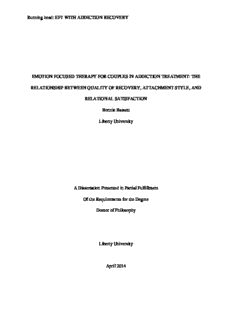
Emotion Focused Therapy for Couples in Addiction Treatment PDF
Preview Emotion Focused Therapy for Couples in Addiction Treatment
Running head: EFT WITH ADDICTION RECOVERY EMOTION FOCUSED THERAPY FOR COUPLES IN ADDICTION TREATMENT: THE RELATIONSHIP BETWEEN QUALITY OF RECOVERY, ATTACHMENT STYLE, AND RELATIONAL SATISFACTION Bonnie Bassett Liberty University A Dissertation Presented in Partial Fulfillment Of the Requirements for the Degree Doctor of Philosophy Liberty University April 2014 EFT WITH ADDICTION RECOVERY © Bonnie Bassett, 2014 EFT WITH ADDICTION RECOVERY EMOTION FOCUSED THERAPY FOR COUPLES IN ADDICTION TREATMENT: THE RELATIONSHIP BETWEEN QUALITY OF RECOVERY, ATTACHMENT STYLE, AND RELATIONAL SATISFACTION by Bonnie Bassett has been approved © April 2014 APPROVED, ACCEPTED, AND SIGNED: __________________________________________ David Jenkins, Ph.D., Committee Chair __________________________________________ John C. Thomas, Ph.D., Ph.D., Committee Member __________________________________________ Fred Volk, Ph.D., Committee Member EFT WITH ADDICTION RECOVERY ABSTRACT This study investigates the efficacy of Emotion Focused Therapy (EFT) for couples in an addiction recovery program. The literature review revealed that individuals with a secure attachment style experience increased relational satisfaction and report better ability to manage life’s challenges as compared with individuals with an insecure attachment style. A pretest- posttest design was used to investigate the effect of EFT on quality of recovery from addiction. The primary measure’s percentile rank scores were comparatively analyzed. A single case multiple baseline design was implemented to draw inferences based on examining the participants’ assessment scores across baseline and intervention phases. The purpose of this study was to demonstrate the effect of EFT by showing that participants reported increased quality of recovery from addiction, movement away from an insecure attachment style and toward a secure attachment style, and increased relational satisfaction when and only when the intervention was applied. This research serves to further the understanding of the role of EFT couple therapy in addiction recovery. Increased knowledge related to how an interpersonal connection can facilitate the recovery process is helpful to practitioners serving this population. i EFT WITH ADDICTION RECOVERY DEDICATION I dedicate my dissertation work to my professors, family, and friends who have supported me along this journey. Thank you all for participating in this amazing experience together with me. I am grateful to my chair, Dr. Jenkins, whose inspirational instruction and counsel gave me a deep appreciation for the research process. His clever ideas and enthusiastic navigation through challenges allowed for the completion of this study. I appreciate Dr. Thomas and Dr. Volk for serving on my committee and for providing their expertise and time. I give special thanks to Dr. Sosin for her kindness in reaching out to me to provide encouragement. I extend my heartfelt gratitude to my family: Dad, Lou, Sharie, Brayden, Bryce, and above all to my helpmate, Mom, for everlasting encouragement throughout my years of study. My heartfelt thanks go to my friends, Carrie, Martha, Mary, Wendy, Claudia, and Laura for walking with me in this process and continuing to express interest well after the novelty wore off. I appreciate the friendships of my fellow doctoral students: Angel, Starr, and Susan; who were in it with me all the while. Collaboratively we processed ideas that took us on cognitive adventures. I am obliged to my coworkers at Tapestry for inspiring me and to Ed at WellStar for generously supporting my academic pursuits. I appreciate Ella, my study break buddy, for reminding me to find joy in moments of play. Finally, I am grateful to my beloved, James, who encouraged me through the research process and created happy and beautiful memories with me along the way. ii EFT WITH ADDICTION RECOVERY ACKNOWLEDGEMENTS I wish to express my gratitude toward the clinicians who gave their time and expertise to make this study a success. As I thank them I want to recognize them for their passion in providing loving care for hurting couples. Michael Barnett: for supervision of clinicians and model fidelity checks Janet Fluker & Patrice Alexander: for facilitating therapy and administering assessments Sue Johnson: for advice toward a sound design Bonnie Bassett iii EFT WITH ADDICTION RECOVERY TABLE OF CONTENTS Page Abstract…………………………………………………………………………………..………...i Dedication…………………………………………………………………………….…………...ii Acknowledgements……………………………………………………………………………….iii List of Tables ..................................................................................................................................ix List of Figures .................................................................................................................................x CHAPTER ONE: INTRODUCTION ...........................................................................................1 Background to the Problem ...........................................................................................................3 Purpose of the Study ......................................................................................................................4 Research Hypotheses......................................................................................................................5 Assumptions and Limitations.........................................................................................................5 Significance of the Study................................................................................................................6 Definition of Terms…….................................................................................................................6 Theoretical and Conceptual Framework ........................................................................................9 Organization of the Remaining Chapters......................................................................................10 Chapter Summary..........................................................................................................................10 CHAPTER TWO: REVIEW OF THE LITERATURE ................................................................12 Introduction....................................................................................................................................12 Attachment Theory........................................................................................................................12 The Strange Situation.................................................................................................................... 13 The Attachment System……........................................................................................................ 14 Internal Working Model of Self and Others................................................................................. 15 iv EFT WITH ADDICTION RECOVERY Mental Model of Self........................................................................................................ 16 Mental Model of Others………………………………………………………………….16 Internal Working Models………………………………………………………………...17 Attachment Styles………………………………………………………………………………..18 Secure Attachment……………………………………………………………………….19 Insecure Attachment……………………………………………………………………..21 Attachment Styles Summary ............................................................................................27 Romantic Attachment………………………….…………………………………...……………27 Relational Conflict……………………………………………………………………….29 Romantic Attachment Summary…………………………………………………………30 Attachment Theory Summary…………………………………………………………………....30 Emotion Focused Therapy…………………………………………………………………….…31 Emotion Focused Therapy Stages………………………………………………………..32 Emotion Focused Therapy Efficacy…………………………………………………...…34 Section Summary……………………………………………………………………………...…35 Addiction and Recovery………………………………………………………………………....35 Addiction and Attachment……………………………………………………………….36 Addiction and Marital Duress…………………………………………………………....39 Couple Therapy for the Treatment of Addiction…………………………………..…….41 Section Summary………………………………………………………………………..……….43 Chapter Summary………………………………………………………………………………..44 CHAPTER THREE: METHODS ................................................................................................ 46 v EFT WITH ADDICTION RECOVERY Research Design ...........................................................................................................................48 Variables………………………………………………………………………………………....50 Independent Variable…………………………………………………………………….50 Dependent Variables……………………………………………………………………..51 Selection of Participants .............................................................................................................. 51 Instrumentation ............................................................................................................................ 52 Background and Demographic Information…………………………………………..…53 Addiction Recovery……………...………………………………………………………54 Attachment Styles …………………………………………………………..………...…65 Romantic Relationship Satisfaction…………………………………………………..….67 Research Procedures……………………………………………………………………………..71 Data Processing and Analysis…………………………………………………………………....72 Research Questions and Null Hypotheses…………………………………………………….....76 Chapter Summary……………………………………………………………………………..…76 CHAPTER FOUR: DATA ANALYSIS AND RESULTS………………..…………………….78 Restatement of the Purpose……………………………………………………………………...78 Preanalysis Steps …………………………………………..……………………………………81 Data Imputation………………………………………………………………………………….84 Results …………………………………………………….…………………………………….85 First Research Question …………………………………………………………………86 Second Research Question………..……………….…………………………………….89 Third Research Question………………………………………………..……………...111 vi EFT WITH ADDICTION RECOVERY Chapter Summary ………………………………………………......………………………….149 CHAPTER FIVE: SUMMARY, CONCLUSIONS, & RECOMMENDATIONS……………..151 Summary………………………………………………………………………………………..151 Participant Selection……………………………………………………………………151 Analysis………………………………………………………………………………...152 Conclusions…………………………………………………………………………………….153 Research Question One………………………………………………………………...154 Second Research Question………… ……….....………………………………………156 Third Research Question…….…………………………………………………………157 Section Summary ………………………….....……………...…………………………159 Implications for Practice………………………………………………………………………..159 Implications for Research………………………………………………………………………160 Limitations of the Study …………….…………………………………………..……………..162 Chapter Summary………………………………………………………………………………163 REFERENCES…………………………………………………………………...…………….165 Appendixes Appendix A: Pre-Post Inventory……………………..…………………………………178 Appendix B: Experiences in Close Relationships Scale……………………..…………179 Appendix C: Dyadic Adjustment Scale ……………………..........................................181 Appendix D: Informed Consent Form……………………………...……………. .…...182 vii
Description: